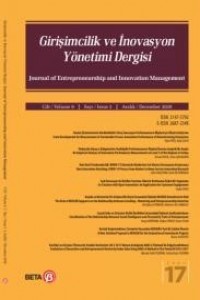Analytical Approach to Innovation Processes: Innovation Analytics
Analytical Approach to Innovation Processes: Innovation Analytics
In this study, it is aimed to understand the concept of innovation analytics by examining what innovation analytics is and to show what kind of models will find application areas for analytical levels. Methodology: Modeling was done for innovation analytics and widely used data analytics and machine learning algorithms were used as well as basic inferential statistical methods for data analysis. Findings: It has been shown that many different types of innovation analytics can be modeled and applied to increase efficiency in innovation processes which are from idea selection to commercialization. Practical Implications: Demonstrating the applicability of innovation analytics types will offer a different perspective to researchers, corporate innovation practitioners, and leaders. Originality: In addition to being the first Turkish study to handle the concept of innovation analytics, it also includes applications for 3 different levels of innovation analytics.
Keywords:
Innovation Analytics, Innovation Process, Data Analytics, Machine Learning Artificial Intelligence,
___
- Arabshahi, H. ve Fazlollahtabar, H. (2018), “Classifying Innovative Activities Using Decision Tree and Gini Index”, International Journal of Innovation and Technology Management, 15(3), 1850025. Brem, A., Giones, F. ve Werle, M. (2021), “The AI Digital Revolution in Innovation: A Conceptual Framework of Artificial Intelligence Technologies for the Management of Innovation”, IEEE Transactions on Engineering Management. Capurro, R., Fiorentino, R., Garzella, S. ve Giudici, A. (2021), “Big data analytics in innovation processes: which forms of dynamic capabilities should be developed and how to embrace digitization?”, European Journal of Innovation Management, 25(6), 273–294. Christensen, K., Nørskov, S., Frederiksen, L. ve Scholderer, J. (2017), “In Search of New Product Ideas: Identifying Ideas in Online Communities by Machine Learning and Text Mining”, Creativity and Innovation Management, 26(1), 17–30. Çubukçu, A. (2022), Yöneticiler İçin İnovasyon Kararlarının Verilmesi, 1.Basım, Ankara: Nobel Bilimsel Eserler. Füller, J., Hutter, K., Wahl, J., Bilgram, V. ve Tekic, Z. (2022), “How AI revolutionizes innovation management – Perceptions and implementation preferences of AI-based innovators”, Technological Forecasting and Social Change, 178, 121598. Haefner, N., Wincent, J., Parida, V. ve Gassmann, O. (2021), “Artificial intelligence and innovation management: A review, framework, and research agenda”, Technological Forecasting and Social Change, 162, 12392. Han, J., Kamber, M. ve Pei, J. (2012), Data Mining Concepts and Techniques, Third Edit, Elsevier. James, G., Witten, D., Hastie, T., ve Tibshirani, R. (2013), An introduction to statistical learning. New York: Springer. Kaggle Veriseti, (2022), HR Analytics classification, https://www.kaggle.com/bhrt97/hr-analytics-classification. (Erişim: 10.06.2022). Kakatkar, C., Bilgram, V. ve Füller, J. (2020), “Innovation analytics: Leveraging artificial intelligence in the innovation process”, Business Horizons, 63(2), 171–181. Maher, M. L. ve Mahzoon, M. J. (2015), “Finding unexpected patterns in citizen science contributions using innovation analytics”, Proceedings of Collective Intelligence, 31. Mariani, M. M. ve Nambisan, S. (2021), “Innovation Analytics and Digital Innovation Experimentation: The Rise of Research-driven Online Review Platforms”, Technological Forecasting and Social Change, 172, 121009. Mariani, M. M., Machado, I., Magrelli, V., ve Dwivedi, Y. K. (2022). “Artificial intelligence in innovation research: a systematic review, conceptual framework, and future research directions”, Technovation, 102623. Padilla-Ospina, A.M., Medina-Vásquez, J.E. ve Ospina-Holguín, J.H. (2021), “Financial Determinants of Innovation in SMEs: A Machine Learning Approach”, Journal of Small Business Strategy, 31(5), 117–131. Pietronudo, M. C., Croidieu, G., ve Schiavone, F. (2022). “A solution looking for problems? A systematic literature review of the rationalizing influence of artificial intelligence on decision-making in innovation management”, Technological Forecasting and Social Change, 182, 121828. Ponta, L., Puliga, G., Oneto, L. ve Manzini, R. (2022), “Identifying the determinants of innovation capability with machine learning and patents”, IEEE Transactions on Engineering Management. 69(5), 2144-2154 Serrallonga, R. (2019), The Future of Innovation Analytics. https://www.datasciencecentral.com/the-future-of-innovation-analytics. (Erişim: 14.04.2022). Shalaby, W., ve Zadrozny, W. (2016), “Innovation analytics using mined semantic analysis”, In The Twenty-Ninth International Flairs Conference. Shalaby, W., Rajshekhar, K., ve Zadrozny, W. (2016). “A visual semantic framework for innovation analytics”, In Proceedings of the AAAI Conference on Artificial Intelligence. The jamovi project (2021), jamovi. (Version 2.0) [Computer Software]. Retrieved from https://www.jamovi.org. Wedel, M. ve Kannan, P.K. (2016), “Marketing analytics for data-rich environments”, Journal of Marketing, 80(6), 97–121. Zabalawi, E., ve Al Jammal, A. (2021), “Innovation Analytics”, In Data Analytics in Marketing, Entrepreneurship, and Innovation (pp. 15-30). Auerbach Publications. Zhang, H., Zhang, X. ve Song, M. (2021), “Deploying AI for New Product Development Success: By embracing and incorporating AI in all stages of NPD, companies can increase their success rate of NPD projects”, Research Technology Management, 64(5), 50–57.
- ISSN: 2147-5792
- Başlangıç: 2012
- Yayıncı: Beta Basım Yayım Dağıtım A.Ş.
